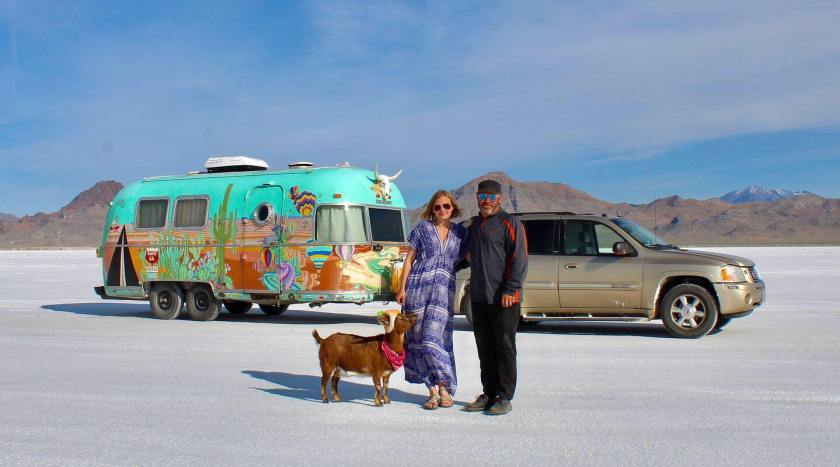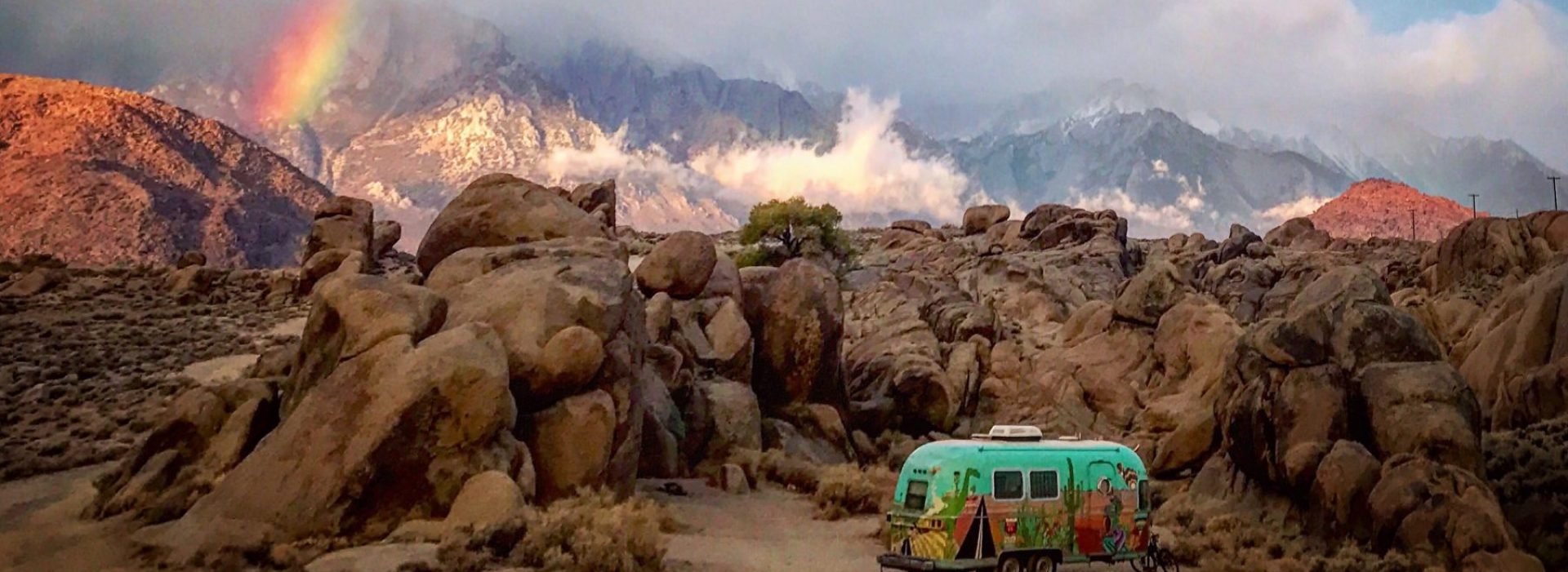
Has Covid spoiled your holiday plans? Whether you don’t feel comfortable getting on a plane yet or you just want to skip the large gatherings, this winter is the perfect time to take a detour from your traditional plans and head to the desert in your RV.
Since we moved to Oregon, the past several winters we have flown back to Asheville, North Carolina to visit the kids and our friends, however, due to current circumstances, we’ve decided to change it up this year and meet them in the Southwest. We plan to revisit some of our favorite spots and also check out some new places we’ve yet to explore. The idea is to do a loop that includes Southern Utah, Nevada, Arizona, and New Mexico. We’ll be visiting some national and state parks along with more off-the beaten-path points of interests. As for camping, we’ll be mostly boondocking on BLM/NF land, but intend on staying at a couple RV parks here and there so we can shower and do laundry.

There are plenty of advantages to traveling this region during the winter, but it also comes with a few caveats and requires extra planning. The #1 challenge: SNOW. Just because it’s the desert doesn’t mean it won’t get cold, especially higher elevations that are prone to getting snow. This means that not everything in the parks will be open; including campgrounds, roads, and trails- so make sure to call or check ahead. It also means that we have to carefully plan our route and watch the weather—staying flexible depending on the forecast. Even when we aren’t traveling during the wintertime, one of the biggest realizations we’ve learned since starting #RVLife is always having a Plan A, B, and even C. Sometimes, you just have to goat with the flow…..
While temperature highs hover between the upper 40s and 60s during the daytime, they can dip down to the 20s at night—- so packing multiple layers, from t-shirts to cold weather gear is a must. It also means that you’ll want to winterize the RV, including filling your propane tanks, prepping your water and sewer systems, and insulating your windows. Like any place that is prone to snow, always bring snow chains and make sure your tires are in good shape.
Though wintertime travel comes with its own limitations, there are also plenty of bonuses!!!
#1 LESS CROWDS

One of my favorite things about traveling during the off-season is the lack of crowds that usually swamp the parks the rest of the year. There is no bigger buzz-kill than arriving at a beautiful destination, only to be surrounded by thousands of tourists with their selfie sticks blocking the views. Popular trails congested with hikers during the busy months thin out in winter, promising a more serene experience in nature and also affords you the opportunity to practice social-distancing. If you want to avoid even more people, start your hike early or explore more popular places during the middle of the week and save the more obscure spots for the weekend.
#2 SNOW ADDS EXTRA MAGIC TO THE LANDSCAPE

One of the most breathtaking landscapes we’ve seen was the Grand Canyon covered in snow. The glistening white powder juxtaposed with the warm, rich colors of the desert is a sight for sore eyes, and a view most National Park visitors never see. Often times, the valleys remain dry while the mountains and mesas are dusted with snow, providing a perfect backdrop for photographers. During dawn and sunset, these snowy peaks light up with alpenglow, turning brilliant orange and pinks.
For those who enjoy winter sports, some of the country’s best ski destinations are in the Southwest, like Telluride, Taos, and Park City. While some of the high altitude roads in the National Parks remain closed to car traffic, they are great spots to cross-country ski and snowshoe.
#3 CHEAPER PRICES AND QUIETER CAMPGROUNDS

One of the best perks about traveling during the wintertime is avoiding the peak-season prices. For those who prefer staying at established campgrounds, many RV parks offer deep discounts during the off-season—which means….more beer money!!!!!! The other plus side is that you don’t have to worry about making reservations a year ahead— campgrounds open during the winter are less likely to be at capacity and are usually more relaxing. Cheers to that!!!!!!!
#4 YOU CAN COMFORTABLY HIKE WITHOUT THE DESERT HEAT

During the summer months, temperatures in the Southwest can be brutal—-no kidding here!. Not only is it hard to go hiking when the scorching temps range between 90 and 115F, it also makes boondocking difficult because you’ll need a constant source of electricity to run you’re A/C— which means lots of generator use or choosing to stay at a full-hookup campground.
Additionally, one of the biggest bummers of traveling during the warm months are the bugs—especially if you are near water. I can’t even tell you how many gorgeous places we’ve camped that were ruined by a relentless swarm of mosquitos. This is another reason why winter camping rocks! Though many places in the Southwest are warm enough to wear shorts and t-shirts during the day, the temperatures plummet to freezing temperatures at night, so most bugs go dormant. Insects aren’t the only things that lay low during these cold months—so do the snakes! We’ve only had the “privilege” of seeing two rattlers in the wild, and that was enough to scare the bejesus out of us. By planning a trip to the desert during the wintertime, you’d be hard pressed to run across these sun-worshipping creatures.
#5 WINTERTIME IS MORE PET-FRIENDLY

If you are traveling with Fido (or goaties), many places you’ll want to visit do not allow animals, with most National Parks only permitting pets on roads, campgrounds, and overlooks. Unlike the hot months that are too dangerous to leave your pets alone in the RV, the cooler temps during the winter make it much safer to leave furbabies alone for a few hours while you explore the area.
Additionally, the summer months are often too hot for animals to hike since they can easily get overheated, which can be very dangerous and even deadly. In general, hiking in the Southwest involves full sun exposure, which makes the ground becomes incredibly hot from spring to fall. This is bad news for pets, whose paws can become blistered unless they are wearing booties. However, during the cold months, the daytime temperatures are pleasant, making it a safer and more enjoyable time for pets on the trails.
How to Plan a Roadtrip
Planning a roadtrip can be both exciting —and overwhelming! There are so many different things to consider before hitting the pavement. For folks that are traveling on a budget like us, it’s vital to make wallet-conscious decisions that involve careful planning so you get the most bang for your buck. While prepping for a trek, things like estimating fuel costs, accommodation fees, and meal planning are some of the things we keep in mind while creating our budget.
THE DYRT PRO APP
”TRIP PLANNER”
Lately, one of the tools we’ve discovered that’s helpful for planning our route is the Dyrt Pro App’s “Trip Planner” feature. This easy app lets you plug in your start and end points, along with other preferences like how many hours you want to spend driving, the kinds of places you want to stay, and what type of roads you want to avoid. Not only does it help you find places to camp along the way, it also helps you determine how much you will be spending on gas. We love the fact that you can customize your settings depending on your rig and preferences.

When it comes to camping, boondocking on public land is the only way we roll, so the Dyrt Pro’s other feature, “Map Layers” , which shows USFS and BLM areas along with peer-reviewed camping spots really comes in handy. If you know the region you will be going, you can download the map ahead of time and access to it off-line when you are far away from cell service.
For those interested in purchasing the
Dyrt Pro App, receive 10% off with discount code: ARGOSY
No matter where you find yourself this winter, we hope you have a wonderful and safe holiday season. If you happen to see us on the road during our trek around the Southwest, make sure to honk and say, “Hay”.
Happy Trails,
Cate, Chad, and Frankie
























Ah Catelyn, great post with lots of wonderful information. But dang! We go south every winter for all the reasons you suggested, but the more that this information is put out there, the more people will go. I fully expect our beautiful deserts to be over run with RV’s this winter. Sigh. Such a bummer. You have a great following…again….dang. There won’t be room for us old folks who head south every year with everyone heading that way. Although the only good thing is that maybe the Canadians will have to stay home this winter, so there still might be room for us in the desert. Happy boondocking!! Maybe we will see you out there.
Hi Sue! It sounds like maybe you go to the more popular places? Spots like Yuma, Tuscon, Quartzite etc attract their fair share of snowbirds, but from our own experience, we hardly ever see other people while we are boondocking- I mean, there are literally millions of acres to spread out in the SW. As for the parks, it’s a fraction of the amount of people that go during the peak season. Of course, you will still see other tourists while visiting places like the Grand Canyon or Horseshoe Bend, but it’s still such a small amount compared with the traffic you get the rest of the year. People are scared of snow and cold weather and that’s enough to deter them. I hope we see you on the road someday though!
Make sure to stop by the “Blue Hole” in Santa Rosa NM ! It’s right off I-40 and definitely worth the stop! Safe travels and keep an eye on the weather!
Oh cool,we definitely will if we go through that area thank you!!!!